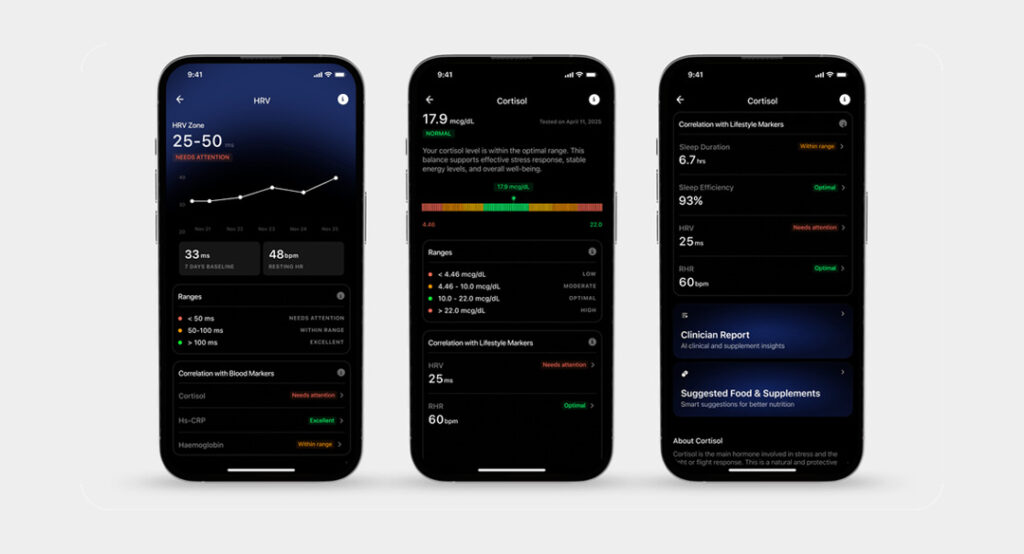Periods are no fun. From cramps, mood swings, and irritability, period discomfort can range from mild to severe. In fact, it’s estimated that as many as three out of four menstruating women have experienced some form of premenstrual syndrome (PMS).
And if PMS wasn’t difficult enough, there exists an even more severe form of PMS called premenstrual dysphoric disorder (PMDD), a condition which affects up to 10% of women who have periods.

Highlights
- Premenstrual dysphoric disorder (PMDD) is a more serious form of premenstrual syndrome (PMS),
- PMDD affects up to 10% of menstruating women,
- PMDD can cause psychological, vascular, neurological and gastrointestinal symptoms.
What is premenstrual dysphoric disorder (PMDD)?
Premenstrual dysphoric disorder (PMDD) is a more serious form of premenstrual syndrome (PMS). One is more prone to get PMDD if one is suffering from anxiety or depression, is experiencing PMS or has a family history of PMS, PMDD or mood disorders.
Medical science hasn’t yet found the exact cause of PMDD. It is assumed that in PMDD, the body has an abnormal reaction to normal changes that occur with each period cycle. These hormonal changes can lead to temporary serotonin deficiency. Serotonin is a chemical that transmits messages between nerve cells in the brain and throughout your body.
Serotonin plays a major role in important body functions like mood, sleep, digestion, bone health, blood clotting and sexual desire. This disruption in the normal production of serotonin could be the reason for one’s unstable mood, abdominal cramps and sleep issues.
How is PMDD different from PMS?
While symptoms of PMS and PMDD are almost similar, the symptoms are heightened with PMDD. For example, with PMS, you may feel sad for no reason, but with PMDD, you can experience extreme depressive episodes and even have suicidal thoughts. With PMS, it’s still possible to go on with your normal day-to-day activities, albeit with discomfort. However, PMDD makes it difficult to even get out of bed. You may also experience such severe mood swings that you may emotionally hurt people around you with your bouts of anger and rage.

What are the symptoms of PMDD?
The symptoms of PMDD usually appear a week (five to eight days) before the start of your monthly cycle and disappear within a few days of your period starting. These symptoms can be so severe that they can disrupt one’s daily routine.
Work, home and personal relationships can all take a hit during this time. Hence, awareness about PMDD is important. It can help others understand why someone suffering from PMDD is behaving in such a way and to be more considerate about it.
The following are the most common symptoms of PMDD:
Psychological symptoms: Irritability, nervousness, lack of control, agitation, anger, poor concentration, depression, severe fatigue, anxiety, confusion, forgetfulness, poor self-image, paranoia, emotional sensitivity, mood swings and trouble falling asleep.
Neurologic and vascular symptoms: Headache, dizziness, fainting spells, numbness, prickling, tingling, or heightened sensitivity of arms and/or legs, getting bruised easily, heart palpitations and muscle spasms.
Respiratory problems: Allergies and infections.
Gastrointestinal symptoms: Abdominal cramps, bloating, constipation, nausea, vomiting, feeling of heaviness or pressure on the pelvis and backache.
Fluid retention: Swelling of the ankles, hands, and feet, temporary weight gain, reduced urine production and breast tenderness.
Others: Eye infection, acne, inflamed skin with itching, poor coordination, change in appetite, hot flashes and painful periods.
How is PMDD diagnosed?
Since PMDD is accompanied by so many physical and psychological symptoms, getting the right diagnosis may take some time.
Firstly, your doctor will take note of your complete medical history. You will also have to take a pelvic exam as well as a few other diagnostic tests.
Secondly, your doctor will ask you to track and write down all the symptoms you are experiencing over two to three menstrual cycles. You may also be asked to jot down the symptoms which are absent during non-period days. Your doctor will keep an eye out for five or more PMDD symptoms, including one mood-related symptom, to diagnose it as PMDD.
Thirdly, because there are so many mental health symptoms attached with PMDD, your doctor may also refer you to a psychologist to rule out any pre-existing mental health conditions.
For a successful diagnosis of PMDD, five or more of the following symptoms must be present during each menstrual cycle over a period of one year: Feelings of depression, anger or irritability, poor concentration, mood swings, sleepiness or trouble sleeping, no interest in otherwise enjoyable activities, food cravings and increased appetite and physical symptoms like abdominal bloating, breast tenderness, and headache. Your doctor may also consider your inability to function at work, at home or in other social situations as one of the symptoms.

What are the natural treatment options for PMDD?
A few treatment options are available for this condition, like taking antidepressants, birth control pills or over-the-counter pain relievers. However, PMDD is a condition that will last till you reach menopause. Hence, one should look at a long-term holistic approach. Following are some of the ways in which you can control the symptoms of PMDD.
Practice aromatherapy: The aroma of your mom’s cooking can flood you with a feeling of love and security. Certain smells and fragrances can evoke feelings of calmness, and aromatherapy centres around this very principle. It involves inhaling essential oils to enhance your physical and mental health. Aromatherapy helps in reducing stress, improving sleep, and relieving pain.
The following essential oils can help with the symptoms of PMDD symptoms:
- Chamomile oil promotes relaxation and sleep,
- Clary sage helps relieve menstrual cramps and anxiety,
- Lavender oil has a calming effect,
- Neroli oil can reduce anxiety,
- Rose oil can relieve stress.
You can practise aromatherapy by adding diluted essential oils to a warm bath or inhaling the scent directly by placing a few drops on a cotton ball and breathing it in. Never apply undiluted essential oil to your skin as it can irritate your skin. Before using essential oils, do a patch test on your skin by applying a few drops of diluted essential oil to your wrist or inner elbow. You can safely use the oil if there is no irritation after 24 hours of application.
Try meditation: Stress can worsen the psychological symptoms of PMDD like anxiety, anger and depression. Mindful meditation requires you to concentrate on your breathing and focus on the now. This can help you detach from the painful symptoms of PMDD. Practising meditation every day, not just on the days before your periods, is necessary. Try to meditate first thing in the morning and the last thing before sleeping, and try to spend at least 10 minutes in meditation.
Regular meditation can help you become mentally resilient, which will help you deal with symptoms of PMDD better. If you cannot meditate on your own, you can join a guided meditation class. You can also download meditation apps that guide you through the whole process of meditation.
Take a warm bath: Warm baths can soothe an aching body and a troubled mind. If you have PMDD, a warm bath can help soothe menstrual cramps, reduce anxiety, and help you get a good night’s sleep. You can also add essential oils to your bath water and indulge in a bit of aromatherapy.
Even soaking your feet in a bucket of scented water can help if you do not have a bathtub. Even a warm shower before sleep can help you get into a more relaxed state of mind. As you get ready for sleep, place a hot bag on your stomach or lower back for further relief from pain and cramps.
Switch up your menstrual products: Menstrual products are absolutely essential during your period; however, some of these period products may worsen the symptoms of PMDD. Tampons, for example, can cause some women to have more cramps than usual. Also, certain ingredients in commercial sanitary pads can cause irritation for people with sensitive skin, which can lead to irritability and stress.
Although there aren’t any scientific studies on how menstrual products impact PMDD, circumstantial evidence advocates that changing them up may ease cramps. All-organic pads, organic period panties and menstrual cups may help ease the symptoms of PMDD.
Eat a nutrient-rich diet: Food is medicine. Eating the right foods is crucial to managing the symptoms of PMDD. Eating healthy can help minimise some of the uncomfortable symptoms; however, science is still unclear about the relationship between PMDD and diet. Understanding the effects of food on our bodies can help us deal with the symptoms of PMDD.
For example, bloating is one of the symptoms of PMDD, and eating salty foods can lead to fluid retention, further aggravating bloating. Extremely sugary foods can cause severe blood sugar fluctuations, worsening symptoms of fatigue and mood swings. Animal proteins and high-fat foods increase prostaglandin levels, which may increase the severity of menstrual cramps.
To reduce the symptoms of PMDD, you should
- Eat 4 to 5 small meals in a day to avoid bloating and stomach upset,
- Eat fresh fruits and vegetables,
- Eat complex carbs such as chapatis, wholewheat bread, quinoa, oats and more,
- Avoid processed carbs like cookies and chips,
- Avoid adding table salt to your meals and avoid salty snacks,
- Avoid caffeine and alcohol,
- Eat high-protein foods (animal protein to be had in a moderate amount) to help increase tryptophan levels.
Get moving with exercise: When suffering from PMDD, the last thing on your mind would be exercise. However, research suggests that regular exercise helps alleviate PMS symptoms and is just as effective for PMDD. When you exercise, a number of neurotransmitters are released, including endorphins, endocannabinoids, and dopamine.
These “feel good” hormones help perk up your mood as well as help you relax. Try to work out for 30 minutes every day and do a combination of aerobic and strength-based exercises. Pilates, swimming and walking are all good forms of aerobic exercises to do on a daily basis.
Give yoga a try: Another form of exercise that’s known to improve menstrual pain is yoga. This ancient practice uses deep breathing, meditation, and certain specific poses to stretch the body, which helps ease pain and promotes relaxation.
The following yoga poses help ease menstrual pain:
- Apanasana (knees-to-chest pose),
- Supta Matsyendrasana (supine spinal twist),
- Balasana (child’s pose),
- Ardha Matsyendrasana (half lord of the fishes pose),
- Utthita Trikonasana (revolved triangle pose),
- Utkata Konasana (goddess pose).
If you don’t know how to do these poses, you can look them up online or take assistance from a qualified yoga teacher.
Look into acupuncture: When you are in pain, pricking yourself with needles may seem illogical. However, acupuncture can be a great tool in reducing the painful symptoms of PMDD. During an acupuncture session, the acupuncturist will insert thin needles into specific points on your skin to help release pain and reduce stress.
The best acupuncture points for menstrual symptoms are:
- Two finger widths below the navel to ease cramps and bloating,
- The bony area between the hips and buttocks alleviates pelvic and back pain,
- The fleshy part between the thumb and forefinger reduces headaches and abdominal pain.
Get seven to eight hours of sound sleep at night: Have you noticed that if you don’t get enough sleep, you find yourself irritable and tired? Imagine having no sleep while undergoing PMDD. This deadly combination can heighten symptoms of depression and anxiety and can also make you more prone to extreme mood swings. To ensure that you get good quality sleep, you must maintain proper sleep hygiene.
Here’s what you can do:
- Go to bed at the same time each night and wake up at the same time every morning. This will reset your body clock,
- Avoid drinking tea, coffee and alcohol a few hours before bedtime,
- Avoid looking at the screen, be it a cell phone, laptop or television, at least 90 minutes before bedtime,
- Avoid taking long naps during the daytime,
- Indulge in some calming bedtime routine before sleep, like reading a self-help book, meditating or applying soothing lotion on your body.
During periods, your body temperature is higher than normal. Keep your bedroom a couple of degrees cooler than your body temperature by turning on the AC. This will help you sleep better.
Go for cognitive behavioural therapy: While we understand that PMDD is not a mental problem but a physical one, going for cognitive behavioural therapy (CBT) may help one deal with the mental symptoms of PMDD. CBT is a type of talk therapy that helps people identify and change obstructive and negative thinking and behaviour styles. CBT can help one cope with mood fluctuations, depression, anxiety attacks and pain.
It can help someone suffering from PMDD channel their pain in a more constructive way. For example, instead of lashing out at a loved one while experiencing particularly painful cramps, one can put on their favourite music and lie down with a hot bag on their belly. It’s all about identifying triggers and changing your response to them.
Conclusion
Premenstrual dysphoric disorder (PMDD) is a more serious form of premenstrual syndrome (PMS). This condition affects up to 10% of women who have periods. This condition is more likely to develop in women suffering from anxiety or depression, who experience PMS or have a family history of PMS, PMDD or mood disorders.
The symptoms of PMS and PMDD are quite similar; however, PMDD can be harder to manage, and the severity of the symptoms can be more extreme and painful. It may be difficult for women suffering from PMDD to go through their day-to-day activities during this period. Although supplements like painkillers and birth control pills help combat these symptoms, natural remedies can be equally effective.
PMDD symptoms will exist until a woman reaches menopause in her 50s; hence, holistic solutions should be preferred as they are a natural and healthier option. Good diet, exercise and natural therapies like acupuncture, aromatherapy and cognitive behavioural therapy can all help in reducing the severity of PMDD symptoms.
Moreover, friends and family members of the one suffering from PMDD should be made aware of this condition to be more empathetic. With the support of friends, family and co-workers, women suffering from PMDD can be less stressed and better able to deal with the symptoms.
Disclaimer:The contents of this article are for general information and educational purposes only. It neither provides any medical advice nor intends to substitute professional medical opinion on the treatment, diagnosis, prevention or alleviation of any disease, disorder or disability. Always consult with your doctor or qualified healthcare professional about your health condition and/or concerns and before undertaking a new healthcare regimen including making any dietary or lifestyle changes.
References
- https://my.clevelandclinic.org/health/articles/9132-premenstrual-dysphoric-disorder-pmdd
- https://www.hopkinsmedicine.org/health/conditions-and-diseases/premenstrual-dysphoric-disorder-pmdd
- https://www.healthline.com/health/womens-health/pmdd-natural-treatment#aromatherapy
- https://www.medicalnewstoday.com/articles/321965#natural-treatments-for-pmdd
- https://www.yogajournal.com/poses/yoga-by-benefit/menstruation/yoga-poses-for-period-cramps/






